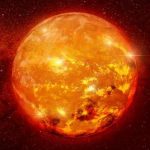 Weird Stuff
Weird Stuff  Weird Stuff
Weird Stuff  Our World
Our World 10 Ways Your Christmas Tree Is More Lit Than You Think
 Movies and TV
Movies and TV The 10 Coolest Stars to Set Sail on The Love Boat
 History
History 10 Things You Didn’t Know About the American National Anthem
 Technology
Technology Top 10 Everyday Tech Buzzwords That Hide a Darker Past
 Humans
Humans 10 Everyday Human Behaviors That Are Actually Survival Instincts
 Animals
Animals 10 Animals That Humiliated and Harmed Historical Leaders
 History
History 10 Most Influential Protests in Modern History
 Creepy
Creepy 10 More Representations of Death from Myth, Legend, and Folktale
 Technology
Technology 10 Scientific Breakthroughs of 2025 That’ll Change Everything
 Weird Stuff
Weird Stuff Ten Bizarre Facts About The Doge Meme
 Our World
Our World 10 Ways Your Christmas Tree Is More Lit Than You Think
 Movies and TV
Movies and TV The 10 Coolest Stars to Set Sail on The Love Boat
Who's Behind Listverse?

Jamie Frater
Head Editor
Jamie founded Listverse due to an insatiable desire to share fascinating, obscure, and bizarre facts. He has been a guest speaker on numerous national radio and television stations and is a five time published author.
More About Us History
History 10 Things You Didn’t Know About the American National Anthem
 Technology
Technology Top 10 Everyday Tech Buzzwords That Hide a Darker Past
 Humans
Humans 10 Everyday Human Behaviors That Are Actually Survival Instincts
 Animals
Animals 10 Animals That Humiliated and Harmed Historical Leaders
 History
History 10 Most Influential Protests in Modern History
 Creepy
Creepy 10 More Representations of Death from Myth, Legend, and Folktale
 Technology
Technology 10 Scientific Breakthroughs of 2025 That’ll Change Everything
Ten Cosmic Secrets That Science Cannot Fully Explain
Astronomers have learned a staggering amount about the cosmos over the last 100 years. It was only in 1924 that Hubble first realized there were galaxies out there other than our own. Now we live in an age of telescopes so advanced, scientists back then could barely have dreamed of them. Physicists around the world have uncovered all kinds of fascinating details about the cosmos.
That said, the skies are still filled with so much that scientists do not understand. Most of the universe remains a secret. Dark matter and dark energy are both shrouded in mystery. Black holes, the universe’s expansion, cosmic rays—space is teeming with riddles and secrets. Some of the greatest minds on the planet have mulled over these ideas, and still, they are not fully understood. So to celebrate just how much we cannot explain, here are ten brain-scratching secrets about the universe.
Related: 10 Signs That the Universe Might Be Alive
10 How and When Will the Universe End?
Looking up to the heavens at the vast expanse of the cosmos, it can be difficult to believe that one day the universe might come to an end. However, physics tells us that the demise of everything as we know it could be on the cards. One group of scientists even claims to have worked out how and when it will happen.
Researchers from around the world collected information from advanced telescopes and surveys to calculate the universe’s fate. Their model suggests the universe has a total lifespan of 33.3 billion years. The universe has been around for over 13 billion years, which means we have around 20 billion years until everything comes to an end.
Physicists predict that seven billion years from now, the universe will stop expanding and begin to contract inward. Eventually, the entire cosmos will dwindle to a single point, hastily collapsing at the end.
The truth is that nobody knows what the fate of the universe will be, or if humans will still be alive to witness it. But some of the greatest minds alive are pondering how and when its finale might play out.[1]
9 Dark Matter Annihilation Could Create a New Type of Star
At the center of galaxies, there might sit a new type of stellar object called a dark dwarf, but no one can say for sure. The theory relates to brown dwarfs, which are similar to stars but with a lower mass. These failed stars suck in some of the material around them—including dark matter, the elusive substance that makes up 85% of the matter in the universe.
Dark matter becomes trapped in the brown dwarfs’ gravitational pull, where it crashes into itself and unleashes enormous amounts of thermal energy. The blistering heat from the dark matter warms the failed stars from brown dwarfs to black dwarfs. In other words, it turns them to the dark side.
Dark matter does not interact directly with other matter, so it usually clumps together at the heart of galaxies. This is where scientists say black dwarfs are most likely to be found. Astronomers plan to use high-powered detectors like NASA’s James Webb Space Telescope (JWST) to scour the skies for black dwarfs. They hope the theory will help them better understand the enigmatic nature of dark matter. But for now, these potential stellar objects remain shrouded in mystery.[2]
8 Where Are the Missing Black Holes?
Somewhere in the vast darkness of space lurk throngs of missing black holes. The cosmic guzzlers come in three size classes. Stellar-mass black holes are around five to 50 times the mass of the Sun. Supermassive black holes are gargantuan and can be found at the heart of most galaxies, including our own Milky Way. Between those two lies the elusive category: intermediate-mass black holes, or IMBHs.
So what are IMBHs like? Well, the truth is that nobody really knows. Scientists are aware that they exist, but when it comes to their origins or how they behave, information is scarce. Researchers around the world are using data from gravitational-wave detectors to try to learn more about the mysterious gluttons.
However, these sensors only offer a tiny glimpse of black holes as they smash into each other and fuse together. Scientists hope that future space-based detectors could help explore IMBHs with a level of precision never seen before.[3]
7 Fast Radio Bursts Shine Light on Hidden Matter
The universe is teeming with hidden matter. Until recently, scientists struggled to account for half of the regular matter in the universe. The dense fog of space shrouds so much, but new technology is helping experts peer deeper into the cosmos. Physicists know it must be out there, circling galaxies as part of their haloes and floating through clouds. But nobody can explain quite where all that hidden stuff is.
Astronomers look for intense blasts of energy called fast radio bursts in the search for the missing matter. These explosions are bright enough that radio pulses pass through the fog and make it to Earth. Here, scientists can calculate the nature of the cosmic mist by working out how much the waves have slowed down.[4]
6 Mysterious Sphere Discovered Thousands of Light Years from Earth
Deep in space lies an elusive giant orb that scientists say is almost a perfect sphere. They know roughly what it is, but the question of how it came into existence has left experts stumped.
Astronomers discovered the structure using the Australian Square Kilometre Array Pathfinder, an advanced network of radio detectors in the Outback. They called it Teleios, from the Greek word for “perfect,” due to its almost faultless round shape. Data suggests the bubble is made from material spat out by an exploding star. But scientists cannot explain quite how it achieved its remarkable form.
Some believe the orb came into being after a Type Ia supernova, where two stars in a binary system erupt, one of which is a white dwarf. However, there is still some uncertainty. Physicists are also unable to work out its size and location. They say its distance from Earth could be anything from 7,000 to 25,000 light years.[5]
5 Dark Matter Particle Might Hide Behind Record Explosion
The brightest explosion ever recorded in the history of the universe was spotted in October 2022. A star 2.4 billion light years away imploded into a black hole. As its core crashed in on itself, it let out a blinding burst of gamma rays with energy reaching as high as 18 teraelectronvolts (TeV). Astronomers dubbed it the BOAT—the Brightest of All Time.
Scientists soon started to wonder if something remarkable lurked behind the glaring explosion. Physicists in Italy say any light particles from that distance with more than 10 TeV of energy should not be visible from Earth.
So what does this all mean? Well, the unexpected detection might have something to do with dark matter. No one knows what dark matter is, but scientists have come up with several theories. One of the leading candidates is a type of hypothetical particle known as the axion.
Experts say that as gamma rays from the record blast zoomed across space, they may have crossed paths with axion-like particles (ALPs). If this happened, the mix of their oscillations would explain why such high-energy particles made it to Earth when theory suggests they should have been absorbed long before they got the chance.[6]
4 What Drives the Most Intense Cosmic Rays in the Universe?
High-energy particles are constantly darting across the universe. Scientists can explain some of them, but when it comes to the most powerful cosmic rays of all, no one is really sure what drives them. These subatomic specks bound across the cosmos at close to the speed of light.
So what is it that builds the particles up to such extreme speeds? Some scientists reckon they might be spat out in the shattering of dying stars, but not everyone is convinced. One issue is that most cosmic rays get buffeted about by magnetic fields as they soar toward Earth. This makes their source nearly impossible to trace. Astronomers have scoured the skies for decades in search of a cosmic accelerator, but still the mystery remains.[7]
3 High-Speed Particles Might Have Frozen into Dark Matter
The great universal enigma that is dark matter is yet to be solved. In May 2025, cosmologists revealed a new theory that attempts to explain the elusive space substance. Guanming Liang and Robert Caldwell believe that dark matter’s origins date back to the early universe. Particles hurtled around the primordial blaze. Many of them slammed into each other and created new matter that had never existed before.
The two physicists put forward the idea that this is how dark matter came about. Particles with little mass collided and suffered a sudden loss of energy. This caused their mass to shoot up instantly. From this, the pair says dark matter was born.
Liang and Caldwell believe their model differs from many others because it is rooted in observational data. “Dark matter started its life as near-massless relativistic particles, almost like light,” Caldwell told reporters. “That’s totally antithetical to what dark matter is thought to be—it is cold lumps that give galaxies their mass. Our theory tries to explain how it went from being light to being lumps.”[8]
2 Is the Milky Way Trapped in a Giant Void?
Our galaxy could be drifting in a great cosmic void that stretches for a billion light years, experts say. No one can say for certain, but evidence points to a possible chasm encircling the Milky Way. Astronomers picked up echoes of sound waves from the Big Bang that they say support the idea that our galaxy is more cut off than once thought.
If this is true, it would help resolve the issue of Hubble Tension. Cosmologists cannot explain why different measurements show that the universe is expanding at different rates. Our area of the cosmos seems to be ballooning at great speed, while far-out regions are growing at a more leisurely pace. If the Milky Way is trapped in a void, the gravitational pull from galaxies outside the chasm drags other nearby galaxies to the edge. That means that to us on Earth, it looks like our region is expanding quicker than it really is.
“A potential solution to this inconsistency is that our Galaxy is close to the centre of a large, local void,” explained Dr. Indranil Banik, a researcher based in Britain. “As the void is emptying out, the velocity of objects away from us would be larger than if the void were not there.”[9]
1 Big Bang Afterglow Might Not Be What It Seems
Modern science tells us that the universe started with the Big Bang. This rapid, intense expansion brought into being everything as we know it. Scientists say this theory is backed up by the faint electromagnetic fuzz that stretches across the whole of space. They call this the Cosmic Microwave Background (CMB). This intergalactic gleam is widely thought to be afterglow from the Big Bang.
However, in May 2025, a new theory emerged suggesting that scientists might have gotten the CMB all wrong. A team from Germany and China says the cosmic glow could be at least partly caused by early-type galaxies (ETGs). CMB, they claim, might not exist at all.
The researchers say that new data points to ETGs forming and spreading through the universe even earlier than previously thought. These radical new models are based on recent data from the James Webb Telescope. The research is still in its early stages, but it raises questions about how scientists view the universe’s evolution.
“Our results are a problem for the standard model of cosmology,” explains University of Bonn physicist Pavel Kroupa. “It might be necessary to rewrite the history of the Universe, at least in part.”[10]








